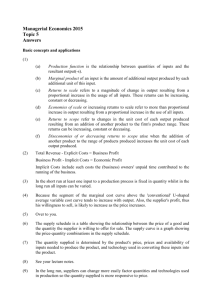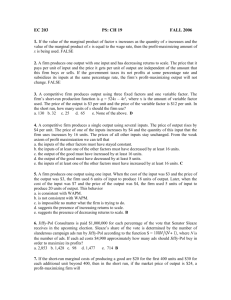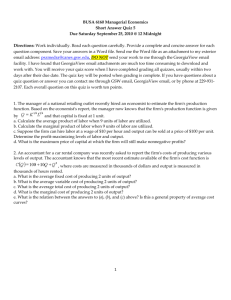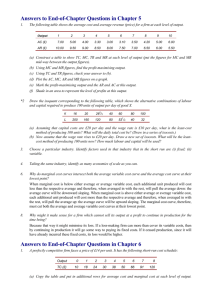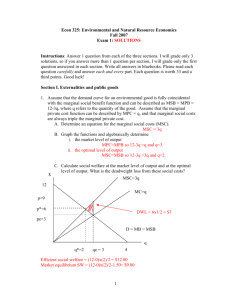Total Revenue (TR) Profit Explicit Cost Implicit Cost Implicit Cost of
advertisement
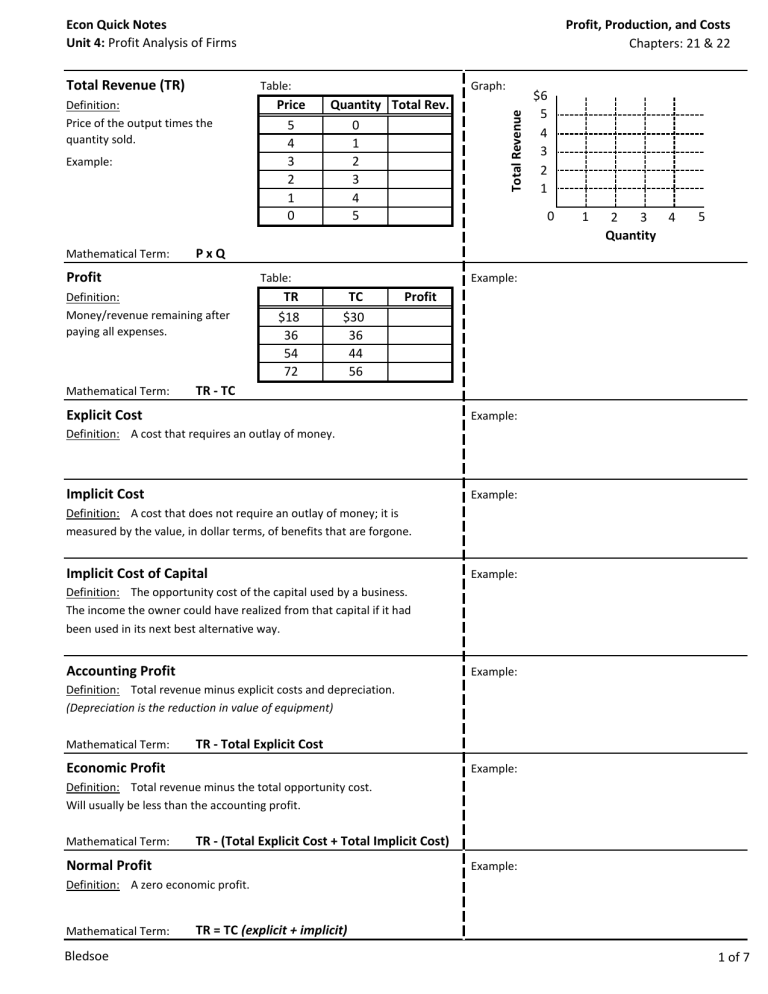
Econ Quick Notes Unit 4: Profit Analysis of Firms Table: Definition: Price of the output times the quantity sold. Example: Mathematical Term: Quantity Total Rev. 0 1 2 3 4 5 $6 5 4 3 2 1 0 1 2 3 4 Quantity 5 PxQ Profit Table: Definition: Money/revenue remaining after paying all expenses. Mathematical Term: Price 5 4 3 2 1 0 Graph: Total Revenue Total Revenue (TR) Profit, Production, and Costs Chapters: 21 & 22 TR $18 36 54 72 Example: TC $30 36 44 56 Profit TR - TC Explicit Cost Example: Definition: A cost that requires an outlay of money. Implicit Cost Example: Definition: A cost that does not require an outlay of money; it is measured by the value, in dollar terms, of benefits that are forgone. Implicit Cost of Capital Example: Definition: The opportunity cost of the capital used by a business. The income the owner could have realized from that capital if it had been used in its next best alternative way. Accounting Profit Example: Definition: Total revenue minus explicit costs and depreciation. (Depreciation is the reduction in value of equipment) Mathematical Term: TR - Total Explicit Cost Economic Profit Example: Definition: Total revenue minus the total opportunity cost. Will usually be less than the accounting profit. Mathematical Term: TR - (Total Explicit Cost + Total Implicit Cost) Normal Profit Example: Definition: A zero economic profit. Mathematical Term: Bledsoe TR = TC (explicit + implicit) 1 of 7 Econ Quick Notes Unit 4: Profit Analysis of Firms Definition: The change in total revenue generated by an additional unit of output. TR MR 0 2 4 6 8 10 12 14 $0 36 72 108 144 180 216 252 - 4 6 Q 8 10 12 14 Graph: Q TC MC 0 2 4 6 8 10 12 14 $28 60 72 88 112 144 184 232 - $28 24 20 16 12 8 4 0 2 4 6 8 10 12 14 Q The marginal cost curve shows how the cost of producing one more unit depends on the quantity that has already been produced. ∆TC / ∆Q Graph: (Draw both curves) Optimal Output Rule Explanation: Profit is maximized by producing the quantity of output at which the marginal revenue of the last unit produced is equal to its marginal cost. Table: (Use the information from above tables to complete) Principle of Marginal Analysis : Every action should continue until marginal benefit equals marginal cost. 2 The marginal revenue curve shows how marginal revenue varies as output varies. Table: Definition: The change in total cost generated by an additional unit of output. $28 24 20 16 12 8 4 0 ∆TR / ∆Q Marginal Cost (MC) Mathematical Term: Q Graph: Q MR MC 0 2 4 6 8 10 12 14 - - Profit *Reminder : Profit = TR -TC, use tables above to calculate. ●If MR > MC, then increasing production will increase profit. ●If MR < MC, then increasing production will decrease profit. ●If MR = MC, then profits are maximized. Price, cost of unit Mathematical Term: Market Price is $18 Marginal Revenue Table: Marginal Cost Marginal Revenue (MR) Profit, Production, and Costs Chapters: 21 & 22 $28 24 20 16 12 8 4 0 2 4 6 8 10 Quantity 12 14 Where the MR curve intersects the MC curve determines the optimal output (maximizes profit) for the firm. Mathematical Term: MR = MC Bledsoe 2 of 7 Econ Quick Notes Unit 4: Profit Analysis of Firms Profit, Production, and Costs Chapters: 21 & 22 Production Function Example: Definition: The relationship between the quantity of inputs a firm uses and the quantity of output it produces. *A firm's production function underlies its cost curves. Fixed Input Example: Definition: An input whose quantity is fixed for a period of time and cannot be varied. Variable Input Example: Definition: An input whose quantity the firm can vary at any time. Short Run Example: Definition: The time period in which at least one input is fixed. Long Run Example: Definition: The time period in which all inputs can be varied. Total Product (TP) Graph: Definition: Total quantity, or total output, of a good produced at each quantity of labor employed. Note: The slope of TP is MP. Mathematical Term: Bledsoe Table: Labor Q of carrots (workers) (bushels) 0 1 2 3 4 5 6 7 8 0 10 26 45 60 70 78 84 88 Total Product Q 90 80 70 60 50 40 30 20 10 0 The total product curve shows how the quantity of output depends on the quantity of the variable input, for a given quantity of the fixed input. 1 2 3 5 4 Labor 6 7 8 Q 3 of 7 Econ Quick Notes Unit 4: Profit Analysis of Firms Profit, Production, and Costs Chapters: 21 & 22 Marginal Product (MP) Definition: Table: The additional quantity of output produced by using one more unit of an input. Graph: MP Q = TP Labor Q of carrots Marginal (workers) (bushels) Product 0 1 2 3 4 5 6 7 8 0 10 26 45 60 70 78 84 88 - Note : Marginal Physical Product (MPP) is the same thing as Marginal Product (MP). Example: ● If MP were to reach 0, then TP would be at its peak. 20 18 16 14 12 10 8 6 4 2 0 1 2 3 Mathematical Term: *MP is the slope of the TP curve ∆TP / ∆L (L represents labor, however ∆I could be used for change in input.) Diminishing Returns 5 4 Labor 6 7 8 Why does this happen? Definition: An increase in the quantity of an input, holding the levels of all other inputs fixed, leads to a decline in the marginal product of that input. Law of diminishing marginal productivity : In the short run, as variable inputs are applied to fixed inputs, production first increases at an increasing rate; then, production increases at a decreasing rate. Average Product (AP) Definition: Labor Q of carrots Average (workers) (bushels) Product 0 1 2 3 4 5 6 7 8 0 10 26 45 60 70 78 84 88 - Relationship between marginal and average curves: ●If marginal > avg, the avg is rising ●If marginal < avg, the avg is falling Mathematical Term: Graph: AP/MP Table: A measure of average labor productivity. Total product divided by the amount of labor employed. On the above graph when do diminishing marginal returns begin? 20 18 16 14 12 10 8 6 4 2 0 MP 1 2 3 5 4 Labor 6 7 8 Q / L or TP / # of inputs Relationship between MP and MC (Explains shape of MC curve) ●If marginal product is rising, marginal cost is falling ●If marginal product is falling, marginal cost is rising *Simply because MP is declining (diminishing returns) and MC is rising does not necessarily mean the firm should discontinue production. Graph: Q $ MC MP Why? Quantity of Labor Bledsoe Quantity of Output 4 of 7 Econ Quick Notes Unit 4: Profit Analysis of Firms Profit, Production, and Costs Chapters: 21 & 22 Fixed Cost (FC) Example: Imagine setting up a successful lemonade stand on your street corner. You are able to sell 1,000 cups a month for $1 each. You have to rent a table from your parents for $75 a month, lemons, sugar and cups cost you $300 a month, and a monthly vendor’s license cost $25 a month.. Definition: A cost that does not depend on the quantity of output produced. It is the cost of the fixed input. Total Fixed Cost (TFC) = Sum of all fixed costs. Variable Cost (VC) Definition: A cost that depends on the quantity of output produced. It is the cost of the variable input. Revenue Fixed Cost Var. Cost Total Cost Profit P= 1.) Q= 2.) 1.) TFC= TR= TVC= TC = Total Variable Cost (TVC) = Sum of all variable costs. Total Cost (TC) Graph: Use the cost table below Definition: The total cost of producing a given quantity of output is the sum of the fixed cost and the variable cost of producing that quantity of output. TFC + TVC Total Cost Mathematical Term: Complete the table using the following information: ● Renting the equipment costs $400 ● Each worker must be paid $200 Output Variable Cost Fixed Cost Total Cost L 0 1 2 3 4 5 6 7 8 Q 0 18 40 55 65 73 78 80 81 VC FC TC Definition: Total cost divided by quantity of output produced. Mathematical Term: Bledsoe Table: (Use the information from above tables to complete) Average Total Cost (ATC) TC / Q Note: Change in total cost is reflected dollar for dollar in change in variable costs. Output Total Cost Avg Total Cost Q 0 18 40 55 65 73 78 80 81 TC ATC - or AFC + AVC 0 20 40 60 80 Output (Q) 100 The total cost curve shows how total cost depends on the quantity of output. Graph: Use the cost table to the left Average Total Cost Q of Labor $2,000 1,800 1,600 1,400 1,200 1,000 800 600 400 200 $32 30 28 26 24 22 20 18 16 15 30 45 60 Q 75 90 5 of 7 Econ Quick Notes Unit 4: Profit Analysis of Firms Definition: The fixed cost per unit of output. Avg Fixed Cost Q 0 18 40 55 65 73 78 80 81 FC 400 400 400 400 400 400 400 400 400 AFC - Output Variable Cost Q 0 18 40 55 65 73 78 80 81 VC 0 200 400 600 800 1000 1200 1400 1600 Graph: Use the cost table to the left $24 21 18 15 12 9 6 3 15 TFC / Q Average Variable Cost (AVC) Definition: The variable cost per unit of output. Mathematical Term: Fixed Cost Avg Variable Cost AVC - 30 45 60 Output (Q) 75 90 Graph: Use the cost table to the left Average Variable Cost Mathematical Term: Output Average Fixed Cost Average Fixed Cost (AFC) Profit, Production, and Costs Chapters: 21 & 22 $24 21 18 15 12 9 6 3 15 TVC / Q 30 45 60 Output (Q) 75 90 Explaining the U-shaped Average Total Cost Curve ATC ● Spreading effect: The larger the output, the greater the quantity of output ● Diminishing returns effect: The larger the output, the greater amount of Cost over which fixed cost is spread, leading to lower average fixed cost. variable inputs required to produce additional units, leading to higher average variable cost. Output (Q) Definition: The quantity of output at which average total cost is lowest. It corresponds to the bottom of the U-shaped average total cost curve. Relationship between marginal and average curves: ●If marginal < avg, the avg is falling ●If marginal > avg, the avg is rising Graph: MC ATC Cost Minimum-cost Output / Minimum Efficient Scale Minimum-cost Output Output (Q) Bledsoe 6 of 7 Econ Quick Notes Unit 4: Behind the Supply Curve: Profit, Production, and Costs Graph: LRATC Cost Long-Run Average Total Cost Curve (LRATC) Definition: Shows the relationship between output and average total cost when fixed cost has been chosen to minimize average total cost for each level of output. Note: Each Short-run Average Total Cost Curve (SRATC) represents a fixed cost that can be chosen. Profit, Production, and Costs Chapters: 21 & 22 Example: Output (Q) Economies of Scale / Increasing Returns to Scale Graph: Economies of scale can result from increasing returns to scale, which exist when output increases more than in proportion to an increase in all inputs (doubling the inputs would more than double the output). Cost Definition: When long-run average total cost declines as output increases. Example: Output (Q) Constant Returns to Scale Graph: Example: Cost Definition: When output increases directly in proportion to an increase in all inputs (doubling the inputs results in doubling the outputs). Output (Q) Diseconomies of Scale / Decreasing Returns to Scale Graph: Diseconomies of scale can result from decreasing returns to scale, which exist when output increases less than in proportion to an increase in all inputs (doubling the inputs would result in less than double the output). Cost Definition: When long-run average total cost increases as output increases. Example: Output (Q) Sunk Cost Example: Definition: A cost that has already been incurred and is nonrecoverable. A sunk cost should be ignored in a decision about future actions. Bledsoe 7 of 7


